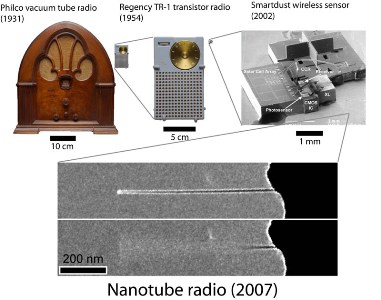Nano-sized radio plays Eric Clapton’s "Layla"

Accurately more nano than the iPod Nano, a radio built out of a single carbon nanotube that detects and plays songs was singled out in the latest issue of Scientific American as one of the first truly functional nanoscale devices that has a "measurable effect on the larger, macroscale world."

Credit: Zettl Research Group, Lawrence Berkeley National Laboratory and University of California at Berkeley
The nanotube radio was developed in 2007 by physicist Alex Zettl and his colleagues at the University of California, Berkeley. It is a fully functional, fully integrated radio receiver, orders-of-magnitude smaller than any previous radio. If you’re in disbelief, you can actually listen to the song “Layla” played on the nanotube radio. (Note there’s a significant amount of static noise since it uses none of the external circuitry to filter or process the signal typically found in typical radios).
Why the nanotube radio sticks out as a milestone in the world of nanotechnology two years after its development is likely two-fold. For one, a functioning miniature of an everyday electronic device that qualifies as a nanoscale machine is pretty cool. Secondly, it’s an achievement that’s relatively easier to understand as compared to most emerging nanotechnology-based applications, especially those in the area of computing and biotechnology.
The nanotube radio is a springboard for progress in several fields according to the researchers:
The nanotube radio, its fabricators say, could be the basis for a range of revolutionary applications: hearing aids, cell phones and iPods small enough to fit completely within the ear canal. The nanoradio “would easily fit inside a living cell,” Zettl says. “One can envision interfaces to brain or muscle functions or radio-controlled devices moving through the bloodstream.
And here’s how it works (Nanotube Radio: Supplementary materials, Zettl Research Group): "The single nanotube serves, at once, as all major components of a radio: antenna, tuner, amplifier, and demodulator. Moreover, the antenna and tuner are implemented in a radically different manner than traditional radios, receiving signals via high frequency mechanical vibrations of the nanotube rather than through traditional electrical means."
Zettl's team realized that a nanotube radio was a possibility during experimentation aimed at producing a nanotube mass sensor. Scientific American states:
One of Zettl’s graduate students, Kenneth Jensen, found that if one end of a carbon nanotube was planted on a surface, creating a cantilever, the beam would vibrate when a molecule landed on its free end. Molecules of different masses would make the beam vibrate at different frequencies. When Zettl noticed that some of these frequencies included those in the commercial radio band, the idea of using the cantilevered nanotube to make a radio became virtually irresistible.
The research was supported by the US National Science Foundation within the Center of Integrated Nanomechanical Systems and by the US Department of Energy.